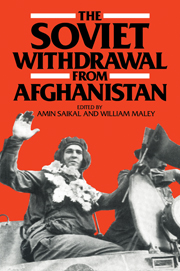Book contents
- Frontmatter
- Contents
- Preface
- 1 Introduction
- 2 The Geneva Accords of April 1988
- 3 Post-Withdrawal Afghanistan: Light at the End of the Tunnel
- 4 The Regional Politics of the Afghan Crisis
- 5 The Afghan Conflict and Soviet Domestic Politics
- 6 The Soviet Armed Forces and the Afghan War
- 7 Afghanistan and Soviet Alliances
- 8 Afghanistan and Sino-Soviet Relations
- 9 The Afghanistan 'Settlement' and the Future of World Politics
- 10 Conclusions: Management of the Afghan Crisis
- List of Contributors
- Index
5 - The Afghan Conflict and Soviet Domestic Politics
Published online by Cambridge University Press: 09 November 2009
- Frontmatter
- Contents
- Preface
- 1 Introduction
- 2 The Geneva Accords of April 1988
- 3 Post-Withdrawal Afghanistan: Light at the End of the Tunnel
- 4 The Regional Politics of the Afghan Crisis
- 5 The Afghan Conflict and Soviet Domestic Politics
- 6 The Soviet Armed Forces and the Afghan War
- 7 Afghanistan and Soviet Alliances
- 8 Afghanistan and Sino-Soviet Relations
- 9 The Afghanistan 'Settlement' and the Future of World Politics
- 10 Conclusions: Management of the Afghan Crisis
- List of Contributors
- Index
Summary
After nine years of active combat Soviet troops have withdrawn from Afghanistan without having achieved the political and military objectives for which they were sent there. Their primary objectives may be summarised as defeating the anti-communist insurgency and firmly installing a communist regime under effective Soviet control. Secondary objectives included advancing the Soviet military frontier a thousand kilometres to the South and to within five hundred kilometres of the Arabian Sea, and demonstrating, as in Hungary in 1956 and Czechoslovakia in 1968, that the USSR will not tolerate satellite regimes in neighbouring states being overthrown and the transition to 'socialism' being reversed. The cost of the Afghanistan enterprise was a major one on several counts. Its purely military costs were kept to a relatively modest level, as Geoffrey Jukes's analysis in Chapter Six shows, and there was doubtless some useful learning. Its costs for Soviet foreign relations, however, both vis-à-vis the Western alliance and the Third World, were profoundly and almost unrelievedly negative. Against this background, withdrawal without having achieved the initial objectives must be counted as a major political and military defeat for the USSR.
Such defeats may have an enormous political impact at home. One has only to recall the role of Russia's failures in the Crimean War as a catalyst for the Great Reforms of the 1860s, including the abolition of serfdom, or in the Russo-Japanese War, which led via the 1905 Revolution to the (sadly aborted) beginnings of a liberal constitutional order.
- Type
- Chapter
- Information
- The Soviet Withdrawal from Afghanistan , pp. 67 - 81Publisher: Cambridge University PressPrint publication year: 1989



